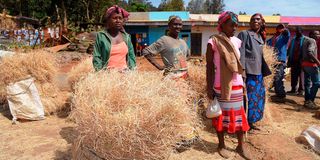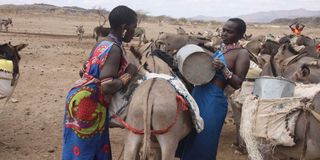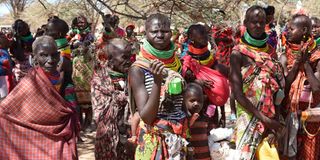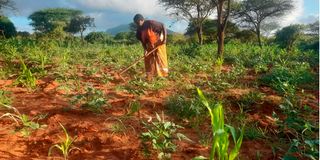Give us water, not fertiliser, Mt Kenya farmers say as region suffers food crisis

Women selling dry grass at Mutuati town, Igembe North, Meru County, wait for customers on June 27, 2022. A food crisis is looming in parts of Mt Kenya region after crops dried up due to biting drought.
A food crisis is looming in parts of Mt Kenya region after crops dried up due to failed rains.
The devastation has left farmers counting huge losses and residents apprehensive about imminent famine.
And as the drought bites, more than 200 elephants have invaded Meru from Isiolo as pasture becomes hard to come by, said Meru National Park senior warden Kitavi Kaloki. The Kenya Wildlife Service (KWS) is mulling opening an elephant corridor linking Imenti forest and northern Kenya amid rising cases of human-wildlife conflict in Meru.

Mr Abdi Boru shows carcasses of cows that have died due to drought in Dabel village, Marsabit County on August 24, 2022.
Mt Kenya residents, who have in the past harvested enough to feed themselves and sell the surplus, now face the prospect of relying on relief food from the government. Already, food is being distributed in Kirinyaga, Embu, Tharaka-Nithi and Meru counties.
Farmers now want the government to prioritise provision of water for irrigation, saying subsidised farm inputs including fertiliser can wait.
Speaking when Meru Senator Kathuri Murungi toured Igembe Central and Igembe North constituencies to assess the extent of damage on crops by marauding elephants, the residents said they needed water and not fertiliser.
“We planted maize and beans but while we harvested some beans, the maize has not matured and as you can see it is withering after rains failed. We don’t expect to harvest anything, yet if we had water we would have a bumper harvest,” said Franklin Mwiti, a farmer in Igembe North.
He said he had planted maize on his five-acre farm and expected to harvest 30 bags but he would be lucky to get five bags.
Sinking of boreholes
“We want the government to prioritise sinking of boreholes, water pans and construction of dams so that we don’t experience this next season.”
“Being provided with relief food is unfair to other regions such as northern Kenya where they can’t grow food crops. We also feel it is demeaning for us to be given food yet we have relied on ourselves all along,” Mr Mwiti added.
Mr Murungi, who is also the Senate deputy speaker, said Meru leaders had mapped out areas where people are in need of water and would prioritise them for construction of dams and sinking of boreholes to tap ground water.
“We will carry out mapping of ground water so that the government ensures there is adequate funding to provide water in these semi-arid areas. Farmers who don’t need fertiliser will get what they want, especially water,” Mr Murungi said.
They spoke even as administrators in Kirinyaga, Embu and Meru reported that over 500,000 people were in dire need of food aid.
In Mbeere South Constituency within Embu County, at least 240,000 people are starving and in dire need of food, with area MP Nephat Muriuki saying there has been insufficient rain in the area for four seasons consecutively.
In most of these areas, crops including maize, the staple food, dried up before they matured following a prolonged dry spell. The most affected areas are Kiambeere, Makima, Mwea and Mavuria villages where residents are struggling to survive.

Women fetch water at in Kajiado.
“For a long period, the area has experienced rain failure and all the crops were wiped out by the scorching sun. This season, the situation is the same and something urgent should be done to save the lives of my people,” said Mr Muriuki, adding that the residents require 60,000 bags of maize and beans to save their lives.
The residents said the drought has hit them so hard and they should be provided with food urgently. They lamented that some of their children were not going to school due to hunger.
“Some of our children cannot learn without food and they are staying at home. A school feeding programme should be started as soon as possible so that the education of our children is not disrupted,” Ms Margaret Wanja, a resident, said.
According to the residents, even their miraa crop has been hit by the harsh weather.
“Miraa has withered and now we have no source of income. Therefore, we can’t meet our financial obligations,” said Mr Francis Maina.
While the government had already released 560 bags of maize and beans to feed starving residents of Mbeere, 260 bags of rice and 300 bags of beans were distributed to cushion vulnerable residents in drought prone areas of Buuri, Tigania East, Tigania West, Igembe Central and Igembe North in Meru county.
In some parts of Tharaka-Nithi, residents are still pleading for relief food. While farmers expected some harvest during the last rainy season, some parts, including Kathangacini and Kanjoro locations did not receive enough to even grow pasture.

Locals wait for their rations of relief food distribution by President William Ruto to hunger victims due to drought, at Nakaalei in Turkana County on November 5, 2022.
The devolved unit’s National Drought Management Authority (NDMA) coordinator Kiragu Kariuki told the Nation that the residents of the drought-hit areas are still looking up to the government to provide relief food.
“In some parts of Tharaka Constituency, residents only harvested some green grams while others did not harvest anything because the areas did not receive any rainfall,” said Mr Kariuki. He added that his office is about to conclude a drought status report, but according to the last data, more than 38,517 residents were in serious need of food and water.
Benson Kithaka, 57, a resident of Kiamiramba in Tharaka North sub-county, said for the last four years the area has not received enough rainfall to enable crop maturity, forcing them to rely on food aid.
“Some years back, we used to harvest enough food in this region, including millet and sorghum, because we would receive enough rainfall, especially the October-December rains. But nowadays, it is dry throughout the year,” said Mr Kithaka.
Mr John Kamwara,62, a resident of Mbacaca in Chiakariga sub-county, said the climate has changed over the years, turning the area into a semi-desert. He said only a few people who live near hills have harvested some millet and green grams this season.
“We used to have bumper harvests of millet, sorghum and cowpeas but our land slowly turned dry and now we have to seek food elsewhere,” he said.
In Nyeri, the county expects another crop failure after three years of failed rains. Most farmers who had grown food crops when rains started pounding the area in December are counting losses as the crops now wither.
In Isiolo, Senator Fatuma Dullo has urged the government to scale-up humanitarian aid to millions of starving Kenyans as the drought continues to wreak havoc in more than half of the counties. Ms Dullo, while distributing maize flour to 4,000 families in Isiolo over the weekend, said there was a need to continuously provide food to ensure no one dies of hunger.
She lamented that the country’s worst drought in 40 years had resulted in drying of water sources and death of livestock in arid and semi-arid areas, making pastoralist communities vulnerable and in dire need of humanitarian help.
“The food rations are meant to cushion the neediest persons and groups across all the communities in Isiolo against the effects of drought. I commit to dedicate my energy towards assisting starving residents as we pray that God grants us enough rain,” Ms Dullo said.
Blame
She blamed poor rains, insecurity and the Covid-19 pandemic have been blamed for the rising food insecurity across the country, with over 300, 000 people in Marsabit and 160,000 in Isiolo facing acute hunger, representing 70 per cent and 60 per cent of the counties’ total populations, respectively.

Ms Jennifer Mwambogho at her farm in Ngolia, Taita Taveta County on January 2, 2023.
The legislator hailed Governor Abdi Ibrahim Guyo for declaring drought a county disaster and appealed to local non-governmental organisations to join hands with the county government to address food insecurity in the region.
Ms Dullo chided President William Ruto over the nationwide tree planting drive saying though important, priority should have been on cushioning hungry Kenyans and ensuring no citizen starves to death.
“The situation is very bad. You cannot plant trees when people are dying. We should plant trees while taking care of hungry Kenyans. The government must up its game and ensure no life is lost,” she noted.
Reporting by Gitonga Marete, George Munene, Alex Njeru, Irene Mugo, Waweru Wairimu, David Muchui and Charles Wanyoro





